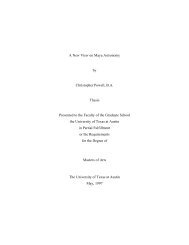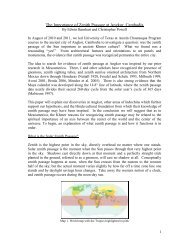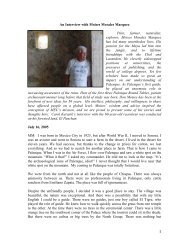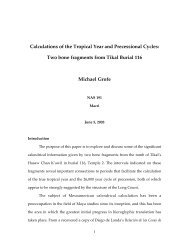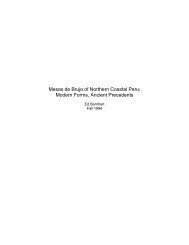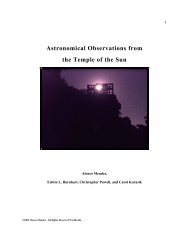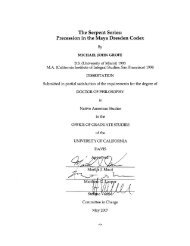2004 Fall - Maya Exploration Center
2004 Fall - Maya Exploration Center
2004 Fall - Maya Exploration Center
You also want an ePaper? Increase the reach of your titles
YUMPU automatically turns print PDFs into web optimized ePapers that Google loves.
MAYA EXPLORATION CENTERFALL <strong>2004</strong>A RCHAEOM AYAThe Newsletter of <strong>Maya</strong> <strong>Exploration</strong> <strong>Center</strong>www.mayaexploration.orgIn This Issue:MEC Archaeologists Featured in a New Documentary• MEC Archaeologiststo Appear in NewDocumentary• MEC Interview Serieswith Robert Laughlin• A Successful ThanksgivingTour in Chiapasand Tabasco• News From Palenque• The MEC TechReport: A NewMEC WebsiteOn The Horizon:• Four Study AbroadsScheduled for Winterand Spring of2005• Capital Campaign forthe Building of theMEC <strong>Center</strong> inPalenque• New Tour Programsto Be Offered byMEC For 2005<strong>Maya</strong> <strong>Exploration</strong> <strong>Center</strong> received an importantinvitation last June. Atlantic Productions,a documentary film companybased in London, had just been commissionedby the History Channel to make aneight-part series entitled, “Lost Worlds.”Upon learning that the MEC team wasmore than willing to contribute its diverseskills and knowledge to the production,Atlantic decided to make Palenque thesubject of the series’ one-hour pilot.The four-man film crew, led by DirectorTom Whitter, arrived in Palenque at theend of July. British archaeologist and authorDavid Drew served as the script consultant.For ten days they filmed the ruins,recreated scenes of ancient <strong>Maya</strong> life, andinterviewed MEC archaeologists on camera.Ed Barnhart discussed the architectureof the Palace and the discoveries madeduring the Palenque Mapping Project. KirkFrench took the camera on a tour of Palenque’saqueduct system. Christopher Powellexplained his current research on <strong>Maya</strong>sacred geometry. For close-ups on dailylife, Powell gave a flint-knapping demonstrationand Alonso Mendez showed howthe <strong>Maya</strong> made stucco. But our great cinematicmoment came on the morning ofzenith passage, when the MEC team recordedthe sun rising directly over theTemple of the Cross.In addition to filming our research, thecrew brought in a crane and the latest digitalequipment to photograph the ruins.<strong>Maya</strong> actors from the San Cristóbal theatregroup Sna Jtz’ibajom reenacted a royalbloodletting ceremony. MEC providedadvice throughout the production, from historicalfacts down to costuming. The filmcrew worked tirelessly, and MEC was happyfor the chance to share our discoveries with awide international audience.Filming in Restaurant Don Mucho, El PanchanBack in London, Atlantic’s post-productionstaff spent three months editing the film,adding CGI animated segments, and scoringthe music. By mid-November they had arough-cut ready for History Channel’s review.History Channel approved the film,and it is now scheduled to air in sometime in2005. MEC’s Winter newsletter will hopefullybe able to provide exact dates.Check out Atlantic Productions on the Web at:www.atlanticproductions.tv
PAGE 2ARCHAEOMAYALetter from the DirectorMEC BoardChairmanDr. Edwin L. BarnhartSecretaryAngela I. MillimanTreasurerBlair DuncanOfficersFred BarnhartMark ChildKirk FrenchCharles C. WilliamsResearch AssociatesJames EckhardtKirk FrenchCarol KarasikAlonso MendezAlfonso MoralesWalter F. MorrisChristopher PowellMEC StaffDirectorDr. Edwin L. BarnhartEditorsDr. Edwin L. BarnhartCarol KarasikContact MECUnited States1901 Big Canyon DriveAustin, Texas 78746Phone: 512-350-3321MexicoEl PanchanApartado Postal 142Palenque, Chiapas 29960, MexicoPhone: 916-348-2896On the Webwww.mayaexploration.orgEmailinfo@mayaexploration.orgContents of this newsletter © <strong>2004</strong> <strong>Maya</strong><strong>Exploration</strong> <strong>Center</strong>, Inc.All rights reserved.The <strong>Fall</strong> Newsletteris coming outa bit late, but forgood reason. Wewere waiting on thegood news that HistoryChannel haspicked up the documentaryon Palenque (discussed onPage One). We’re very excited about itsfuture airing and the opportunity itgave us to discuss our latest research. Itshould also do wonders for MEC’s visibility!This <strong>Fall</strong>, while school was in session,MEC’s public outreach has been primarilythrough tours. After two small educationaltours in September and October,we hosted our biggest group in November.Eighteen people participated inthe Thanksgiving Tour and the mainevent was an American-style turkeydinner in Palenque. Read more aboutthat tour in this newsletter.MEC’s dream to build a public educationcenter in Palenque came a little closer toreality this <strong>Fall</strong>. We have found a perfecttract of land and have begun negotiations.With that possibility in view, wecan now complete the written conceptplan for presentation to potential fundingsources in January.Now it’s December, and as MEC completesits first full year, we are taking abreak to be with our families for the holidays.We’ll be right back at it in January,with our first of six scheduled studyabroad programs, continued plans for thebuilding of a public education center, andthe roll out of our redesigned website.As always, I want to thank you all foryour continued support and ask you tostay tuned for more big things from MECin 2005.HappyHolidays,MEC Tech Report: A New WebsiteComing early next year, <strong>Maya</strong> <strong>Exploration</strong><strong>Center</strong>’s website will have a newlook, and some new features. Web designerTed O’Louglin of Worx Media hasbeen redesigning the site this <strong>Fall</strong> and isnow adding the final touches. The contentof the site will be essentially the same, witha few additional resource sections and areorganization of certain pages. A new leftside navigation bar will give visitors a simplerway to peruse the site.Primarily the improvements focus on layoutand the site’s overall flow. The contact,registration, and donation pages will bestreamlined for ease of use. The “In theField” section, renamed the “<strong>Maya</strong> Minute,”will feature factoids about <strong>Maya</strong> historyand archaeology, to be continuouslyupdated. MEC is looking forward to theredesigned website’s launch sometime inJanuary 2005.
PAGE 3ARCHAEOMAYAA Successful Thanksgiving Tour in Tabasco and ChiapasIn late November, MEC hosted its largest tour to date.Attended by 18 people, the Thanksgiving Tour turned outto be so popular that we had to close admission. Despitethe group’s large size, participants had a great time.Robert Cox, who was traveling with his wife Nancy anddaughter Laura, wrote, “We had a wonderful time. For mypart, I believe that this was the best vacation that I've everhad.”In addition to the regular tours of the ruins and eveninglectures, the group enjoyed a festive Thanksgiving dinner.With the families and friends of MEC’s staff joiningthe tour participants, the dinner swelled to 40 people.Sixty pounds of turkey and all the trimmings were expertlyprepared by MEC associates (and caterers) CathyKahn, Susan Mendez, and Angela Milliman. RestaurantDon Mucho’s provided space and service for the event. Inthis tropical jungle setting, everyone relished a delicioushome-cooked meal and the warm company that marksthe true spirit of Thanksgiving.Thanksgiving Dinner at Restaurant Don Mucho, El Panchanlike we were parting from close friends at the end of the week.”Another wrote, “I was totally impressed with the team of expertsyou put together to lead us and teach us about their disciplines.”A Portion of The Group on Their Way to Piedras NegrasBesides our standard tours of Yaxchilan, Bonampak, Tonina,and Palenque, November’s participants enjoyed afew new additions to the MEC itinerary. One was an excursionto the beautiful blue cascades of GolondrinasWaterfalls. Seven tour members also visited Piedras Negras,a major, but remote, <strong>Maya</strong> site on the UsumacintaRiver. Previously accessible only by a 20-kilometer jungletrail, a recently improved dirt road now provides accessto a point just down river from the ruins. Our seven intrepidtravelers were among the first tourists to visit thesite via the new route. After most of the group flew home,six participants went on to San Cristóbal, in the ChiapasHighlands. There, anthropologist Chip Morris introducedthem to the traditional <strong>Maya</strong> villages of Zinacantán andChamula.The entire MEC team was involved in the tour. Participantswere divided into small groups so that they couldreceive more personalized attention from their respectiveguides. This also gave them a chance to get to know oneother better. One participant wrote, “Our guides, Alonso,Alfonso, and Christopher were each interesting, informative,and fun to be with. The people in the group were great. I feltEveryone on the tour had a fun, and educational, vacation.Tour member Catherine Novotny emailed MEC afterwardssaying, “Thank you for a trip that exceeded my highexpectations.” With such a successful first run, ThanksgivingTour in Palenque is likely to become a MEC tradition.
PAGE 4MEC Interview with Robert LaughlinARCHAEOMAYAIn this issue of Archeo<strong>Maya</strong> is a conversation betweenDr. Robert Laughlin and Alonso Mendez. Dr. RobertM. Laughlin, Curator of Anthropology at the SmithsonianInstitution, long career as a cultural anthropologist,ethnobotanist, and linguist dedicated to preservingthe oral traditions of the Tzotzil <strong>Maya</strong> of Zinacantán, asmall community in the Highlands of Chiapas, Mexico.His two-volume monograph, The Flowering of Man, is amajor ethnobotanical source on plants of the highlands.His translation of a sixteenth century Tzotzil dictionaryis of immeasurable help to epigraphers and ethnographers,as is The Great Tzotzil Dictionary of San Lorenzoinacantán, which took sixteen years to complete. <strong>Maya</strong>nTales from Zinacantán: Dreams and Stories from the Peopleof the Bat, edited by Carol Karasik. Bob Laughlin startedout as a poet who then took on the painstaking task ofrecording an exotic foreign language. It perfumes ourhearts that PEN has recognized the literary merits ofDr. Laughlin’s work, as well as the richness and vitalityof <strong>Maya</strong> oral literature , by giving him the PEN’s GregoryKolovakov Award for Translation of Latin AmericanLiterature into English.The interview took place in mid-December of lastyear at Restaurant Don Mucho in Palenque. Excerptsfrom the interview with Robert Laughlin are below. Toread the full interview visit our website at: http://www.mayaexploration.org/interviews.aspxAlonso Mendez: Welcome to Palenque, and thank youfor being here to answer these questions.Robert Laughlin: Thank you for considering me worthyof interview.AM: As an anthropologist working closely with theHighland <strong>Maya</strong> of Chiapas for many years, you havehad the opportunity to see a lot of history unfold.Could you tell us a little about that history, and howyou came to work in Chiapas?RL: Well, I first came in the spring of 1957. When I wasat the Escuela Nacional de Antropología e Historia inMexico City, one of my fellow students said, “Oh, youmust go to San Cristóbal and visit Na Bolom, see thewonderful library and listen to Pancho Blom’s wonderfulstories. So I came up for a week in my little volkswagon.There were about five cars then in SanDr Robert M. Laughlin, 2002Cristóbal, and of courseone of them smashedinto mine. Then I didsomething I’d neverdone before in my life. Ican’t imagine why, but Ihid my money in theashtray. Right after thecrash the guy said,“We’ll take the car to amechanic and I’ll pay forit.” Because I had hiddenmy money in the ashtray,the mechanic found it. Soit was a long story of gettingout of Chiapas, but Imade it, finally, withpractically no money.At the Escuela, almost all my fellow students had greyhair, and I soon came to realize why they had grey hair:they were all waiting to get their degrees. The Escuelawas near the cathedral, and even though it was in a centrallocation, the electricity kept going out. The professorsearned such a low salary that they had two or three jobsand often didn’t come to class. But most important werethe student strikes that would go on for weeks. I was tremendouslylucky to be in the last class of Miguel Covarrubias,who was marvelous, and also Jiménez Moreno,who was a very good historian. But I didn’t see how I wasever going to get a degree there and so I applied to Harvard.Then, after visiting San Cristóbal, I decided to join INI[National Indigenous Institute] as a volunteer down inthe Papaloapan area of Veracruz. They were closing theMiguel Aleman Dam, and I accompanied a member ofINI to the various towns that were being displaced. Peoplewere living in rock fields and in towns where it wassaid that “even the fleas had died here.” I had never inmy life seen such terrible things being done to people.While I was there, I got a telegram from my father saying,“You have been drafted into the army, call me tonight.”The telegram had been sent two weeks before. Finally Icalled my father and miraculously, during those twoweeks, my acceptance had come from Harvard and I wasable to get a student deferment.I entered Harvard grad school just at the point whenEvon Vogt was starting the Harvard Chiapas Project,
PAGE 5ARCHAEOMAYAstudying social change in Zinacantán. He wanted me tostudy corn, but I wasn’t interested in corn at that time. Iwanted to collect myths and folktales, and he said, “Fine,go ahead.” And so I spent a year in Zinacantán doing justthat. For my dissertation I compared courtship among theZinacantecs with the folktales and myths about courtship.After that I collected dreams. Dreams are so important.People wake each other up in the middle of the night totell a family member a dream, and they remember somedreams for years. I thought I’d publish them, but when Italked to Americans, they said, well, you have to analyzethem. I had never had any psychological training in analyzingdreams, so I put them aside and thought, “Here Ihave this list of vocabulary that I’ve learned collecting themyths and dreams. I’ll just write a dictionary. It will beeasy.” That took fourteen years!AM: In retrospect, would you have done it if you hadknown that it would be such a difficult task?RL: Probably not. But it was an exciting time, because atthat point, there was no sure alphabet for Tzotzil <strong>Maya</strong>.Lore Colby, my predecessor in the Harvard Chiapas Project,helped me work out some of the problems with thealphabet. Then, to collect the words for the dictionary, Iused a terribly boring method. Because most of the <strong>Maya</strong>nroots are monosyllabic, I would test each combinationof letters, and as I learned suffixes, add those on andask, “Is there such a word as that?” We got some prettyfunny ones, especially an incredible number of onomatopoeicwords for sounds of insects, men pissing, womenpeeing, horses pissing. I’ve just been reading a bookabout the J’mong people from Laos and the same is trueof the J’mong language before it was written down, similarsounds for trees rustling in the wind, fruit ploppingon the ground. This is something that the Spanish languageis very poor in. For instance, we never got a goodSpanish translation for the sound of a horse clip-cloppingdown a street.AM: The Great Tzotzil Dictionary of San Lorenzo Zinacantánhas been a very valuable resource for epigraphers. WhenI was studying with Linda Schele at the <strong>Maya</strong> Meetings inTexas, your dictionary was essential in helping us figureout the meaning of many of the hieroglyphs. Have youhad any interest in the ancient <strong>Maya</strong> writing system, andhow does the dictionary and your study of the languagecompare to what you have read or understand about theepigraphy?R L: You know, I’ve really avoided this subject. I’venever learned to read the glyphs. I’ve thought, well, I’lljust put out what I can for others to do rather than do itmyself. When I was organizing my colonial dictionary,The Great Tzotzil Dictionary of Santo Domingo Zinacantán, Ithought it would be helpful to create a thesaurus andgroup the words by subject, which would make it mucheasier for people who were working on epigraphy.AM: Surely you must have gotten some interesting feedbackfrom epigraphers. Do they contact you every nowand then?RL: Occasionally, but they haven’t done it for years now.Linda Schele was the first to talk to me. I remember onemeeting where it seemed like the world was just going tohell. I can’t remember what was going on. My wife and Ihad dinner with her in Texas, and something just terriblewas happening in the world, and Linda said, “I’ve neverbeen happier in my life,” and that was because of herwork. At the time everyone was accepting her ideas. But,you know, if you asked a Zinacantec about any one ofthese ideas, they’d say, “No, that’s not the truth.” Thatwas surprising.AM: Speaking about world events, and particularly thoseshocking events that affect us all, I know that worldevents are becoming more and more vivid to contemporary<strong>Maya</strong> through TV and the Internet. How do you seethis more cosmopolitan view affecting the modern <strong>Maya</strong>and their way of thinking?RL: Well, I remember when the Persian Gulf War wasshown on TV and was seen by Zinacantecs. My compadreAnselmo Pérez Pérez was the top shaman in Zinacantán,and he had all the shamans go up to the mountain to prayfor protection, because there was no sense of the distance.Where was Iraq compared to Chiapas? Maybe it was justover the hill. Another thing that I remember was when Itook Anselmo and Domingo de la Torre to the AmericanAnthropological Association meetings in San Francisco in1963, and Laura Nader, the social anthropologist, cameup to me, weeping, and said, “They’ve just shot Kennedy.”The first time Anselmo and Domingo everwatched TV they saw Jack Ruby shoot Oswald, so itseemed like the United States was a pretty dangerousplace to live in. I remember Anselmo saying that the manwho shot President Kennedy had never even spoken tohim. That was an inconceivable thought.In 1994 when our theatre group, Sna Jtz’ibajom, went tothe University of Florida, the word “pan-<strong>Maya</strong>n” cameup. None of our group had ever heard of such a word aspan-<strong>Maya</strong>n, and wondered what that was. Now they allknow what that is!
PAGE 6News from PalenqueStuart Takes UT Schele Chair—The Universityof Texas at Austin’s Art History Departmenthas appointed Dr. David Stuartas the new Linda Schele Chair Professor.The year-long search for a successor to Dr.Nikolai Grube finally ended this summer.Stuart, who gave up a prestigious positionat Harvard University, was chosen for theChair after extensive interviews and presentationsfor the students of the department.Runner-up for the position was renownedMixtec scholar Dr. John Pohl ofUCLA. While Pohl would have been agreat choice for UT, Stuart’s foci on <strong>Maya</strong>art and hieroglyphic writing were ultimatelya better match for the Schele Chair.MEC is pleased to welcome Dr. Stuart tothe Austin community, and we encourageeveryone to attend his workshops at theupcoming Texas <strong>Maya</strong> Meetings, March11-16, 2005. For more info, go to:www.utexas.edu/research/chaaac.A New INAH Director at Palenque—Palenque has a new administrative director.In October <strong>2004</strong>, INAH appointedFrancisco Lastra to the post. As Director ofPalenque’s archaeological site, Lastra alsoadministers Yaxchilan, Bonampak, and allother sites in Chiapas Region IV. Formerlythe head of the Federal Electricity Comissionof Chiapas, Lastra is no stranger tothe challenges of government-based management.Having lived in Palenque fordecades, Lastra is the first “local” Site Directorin Palenque’s history. OutgoingDirector, Juan Antonio Ferrer, has movedon to become INAH Director of Archaeologyfor the state of Tabasco. There is nodoubt that Tabasco will benefit from hisintegrity and passion for his work, qualitiesthat were apparent during his time atPalenque. MEC looks forward to a productiverelationship with incoming DirectorLastra as well as new opportunities towork with Director Ferrer in Tabasco.MEC Announces First Capital Campaign<strong>Maya</strong> <strong>Exploration</strong> <strong>Center</strong> has set agoal of giving Palenque somethingit has never had: a public educationcenter where visitors can interactwith archaeologists. This has beenour goal from the beginning; hencethe name <strong>Maya</strong> <strong>Exploration</strong>“<strong>Center</strong>.” Our current small officeand lecture space are only an interimstep on the way to creating amore prominent education and researchfacility.In 1999 about 240,000 people visitedPalenque. By 2003 that numberPotential Tract of Land for the MEC <strong>Center</strong> in Palenquehad risen to 750,000. That madePalenque the fourth most populararchaeological site in Mexico. Accordingto projections for <strong>2004</strong>, thenumber of visitors to Palenque willcrest at one million. At present, visitorsmay explore the ruins, strollthrough its on-site museum, andhire a local guide. However, theyhave no opportunity to learn fromarchaeologists who work at the site.MEC’s plan is to build a centeralong the road to the ruins, accessibleto thousands of daily touristsand local residents. Designed in thesame architectural style as Palenque,the center will include an auditorium,exhibition hall, bookstore,library, classrooms, and an observatory.Daily lectures in the center’s airconditionedauditorium (in Englishand Spanish) will give visitors achance to meet and ask questions oflocal archaeologists. The center willalso offer intensive courses on the<strong>Maya</strong> as well as language classes,artisan workshops, and more. It willbecome a way to disseminate researchdirectly to the public.After preparing the concept plan andstudying Palenque’s real estate forover a year, we are finally ready toact. MEC has locatedan ideal tract of landon which to build thecenter, one with aview of the ruins andaccess to neededutilities. Now wemust begin a capitalcampaign to procureit. Because of the explosivegrowth inPalenque’s touristtraffic, land along theroad is being boughtup by entrepreneursand real estate prospectors. If we areto obtain the right tract for the center,we must act quickly. MEC is nowactively soliciting patrons to helppurchase our target two hectares(four acres) of land. If you are interestedin helping, we would be happyto send you the MEC proposal,which outlines both the specifics ofthe tract and the concept plan for thecenter itself. For a copy of the proposalor to make a contribution, contactDr. Ed Barnhart at edbarnhart@mayaexploration.org..ARCHAEOMAYA
PAGE 7News from Palenque (Cont.)A New Waterfalls to Visit in Chiapas—Earlier this year a new waterfall in theMonte Azul Biosphere was opened tothe general public. Named CasacadasGolondrinas (“The Swallows Waterfalls”),their beauty rivals that of thefamous Agua Azul <strong>Fall</strong>s. Fortunately,Golondrinas has been spared the kindof over-development Agua Azul hassuffered in recent years. The local Chol<strong>Maya</strong> have installed only simple changing rooms and a fewpicnic tables. It’s the perfect place to relax and swim after avisit to the nearby ruins of Bonampak. To get there, simplytake the right turn towards Plan de Ayutla, just 10 km beforethe entrance to Bonampak. The falls are only one kmdown that road and clearly marked with signs.Why Donate to MEC ?ARCHAEOMAYAIf you’re interested in the search for the lost knowledgeof the ancients, you should support <strong>Maya</strong> <strong>Exploration</strong><strong>Center</strong>. MEC is at the forefront of research thatis making a real difference in our understanding of theancient <strong>Maya</strong>. In addition, our education programsencourage students to step away from classrooms andinto to the ruins to see for themselves.Our education programs are enriched by current researchand, in turn, on-going research is supportedthrough the funds raised through our education programs.Support MEC’s non-profit organization todayand help us carve new paths between the ancient<strong>Maya</strong> and modern public awareness.Thanks to Everyone Who Has Donated to MEC This <strong>Fall</strong>Robert and Nancy Cox • Anne Dibble • Jack and Mary Dodge • Terry Glenn • Dee Ann StoryKana Honda • Catherine Novotny • David and Elaine Schele • David and Karen StokesRobert and Judith Tidwell • George and Lurline TwistA Perfect Gift For The Holiday SeasonLooking for a last-second Christmas gift for someone special? Make a charitable donation to <strong>Maya</strong> <strong>Exploration</strong><strong>Center</strong> in their name. MEC will send a holiday card telling them who made the donation and how their contributionwill support advances in the field of <strong>Maya</strong> archaeology. Please help this holiday season by giving to <strong>Maya</strong><strong>Exploration</strong> <strong>Center</strong>. Need an end of the year write off? Look no further....Donate to <strong>Maya</strong> <strong>Exploration</strong> <strong>Center</strong>Your support is crucial. Please help us to continue to do this important research. Donate today.Amount Donated:Method of PaymentCheckVisaMasterCardNameAddressPhone<strong>Maya</strong> <strong>Exploration</strong> <strong>Center</strong>, Inc., is a501(c)(3), Texas Non-Profit Corporation.Your donations are tax deductible.Credit Card #Exp. dateSignaturePlease mail donations to: <strong>Maya</strong> <strong>Exploration</strong> <strong>Center</strong>, 1901 Big Canyon Drive, Austin, Texas 78746Credit Card Donations can also be made on our website: www.mayaexploration.org/donate.aspx



